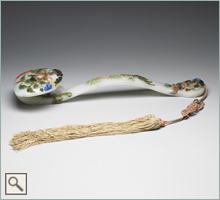Ming dynasty may be considered as one of the most intriguing and complicated times in Chinese history, at once a totalitarian rule which was extremely conservative and a merchandise economy which started to loosen up its traditional, rigid social hierarchy. In art and culture, the duality expressed itself through highly changeable, even contradictory styles in juxtaposition. Jades of the period was no exception to the zeitgeist and developed into brand new looks combining humanistic and secular tastes. Influenced by the concept that "the art of craft approaches Dao the Way", the Ming literati assist artisans in creative works, which sometimes could even lead to the appearance of brand names, highly regarded by all.
Under the patronage of the jade-loving Emperor Qianlong of the Qing dynasty, jade carvings enjoyed unprecedented growth and peaked. Another contributing factor was the steady inflow of raw materials from Khotan after His Majesty conquered the Uygur region of Eastern Turkistan in 1760, his 25th regnal year. All elements and conditions were perfectly in place for a thriving jade industry where an interesting phenomenon of diversity also emerged: the market's taste diverging from the imperial preference, elegance and vulgarity coexisting, and the retro clashing with the trend. All added to the fun and richness of the period looks.
After the Qianlong zenith of refinement Chinese jade arts gradually sloped to a lull during which new ideas were brewing; the most significant turn was with the very concept about "jade". For 7000 years, jade to Chinese had always meant creamy, tender nephrite with its quiet beauty, whereas now jadeite arrived in its dazzling emerald green, soon capturing the hearts of recent and modern Chinese. Its glamour has since reigned.
The Ingenuity of Jade Carvings section consists of four themes. First, an updated review of the notion "Rough and Large Ming Jades", to better understand the versatility present in Ming styles. Next, the palace jades inscribed "imperially made", "for imperial use", or with imperial poetry, to let these imposing royal jades to speak of their own grandeur, and to reveal how Emperor Qianlong had steered the period styles of his beloved jades. Last, the most recent carvings from the late Qing to early Republican era, to explore the favorite jade types and characteristics of the modern jade lovers.
Best Materials at the Imperial Capital; Finest Artisans in the Town of Suzhou
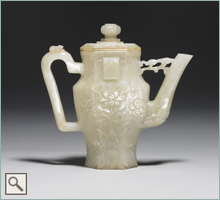 Jade Ewer with "longevity"
Jade Ewer with "longevity" character and floral pattern
Mid to late Ming dynasty
1436-1644 C.E.
H. 15 cm W. 15.8 cm
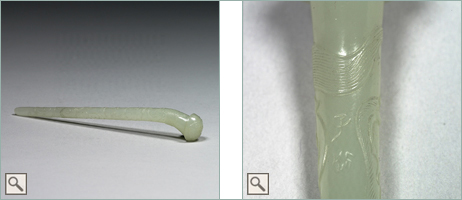
| Jade Hairpin inscribed signature Zigang with chi tiger pattern Late Ming dynasty 1522-1644 C.E. L. 12.6 cm H. 1.2 cm |
Signature of Zigang |
The Imperial Grandeur of High Qing
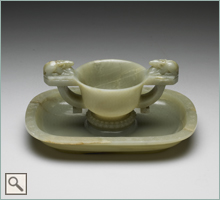 Jade Cup and Saucer
Jade Cup and SaucerQianlong Reign
Qing dynasty
1736-1795 C.E.
Cup:H. 6.5 cm Diam. 7.4 cm
Saucer:H. 2.4 cm L. 17.6 cm W. 12.6 cm
The Retro and the Trendy
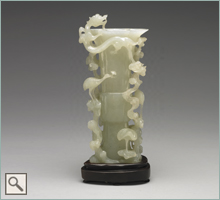 Jade Gu-shaped Vase with
Jade Gu-shaped Vase with dragon-in-the-cloud and
divine-crane motif
Mid Qing dynasty
1736-1820 C.E.
H. 15.7 cm
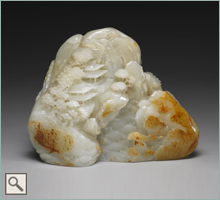 Jade carving with fairy-landscape
Jade carving with fairy-landscape motif in mountain style
Qianlong Reign
Qing dynasty
1736-1795 C.E.
H. 16.4 cm W. 21.7 cm
The New Taste




